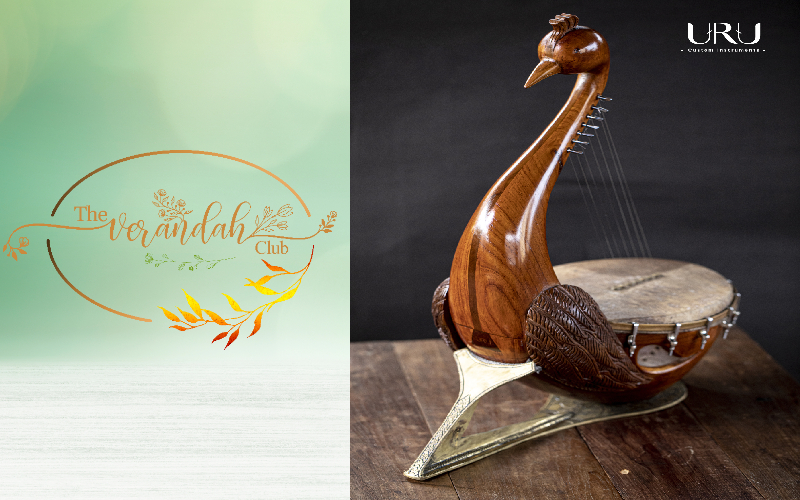
“…As the dusk set in, the cowherd took out what looked like a bow-shaped object. It was ‘Vil Yazh’, a bow-shaped musical instrument, which the cowherd had designed. He had arched the branch of the kumizh maram (Gmelina Asiatica) and stringed it using the twine from the ‘maral’ (Sanievicria Roxburghiana).”
(Source: ‘Yazh Nool’ by Swami Vipulananda, 1947).
According to another research paper, a hunter first created a ‘Vil Yazh’ inspired by the mellifluous ‘twang’ sound of the bow. Yet another story says that the musical nomads called ‘paanars’ created the yazh. It is said that as a token of appreciation of their talent, they were gifted the place called ‘Yazh paanam’.
The true birthplace of this 3000-plus-year-old stringed instrument ‘Yazh’ is believed to be Tamil Nadu and Sri Lanka. The development of Yazh led to the creation of instruments like Veena in later years. The first form of Yazh is believed to be Vil Yazh, a single-stringed yazh, that is similar to an Ektara (a single-stringed instrument from North India).
According to the book ‘Yazh Nool,’ there is no recorded information about what transpired with the Yazh during the interim period till the Sangam era.
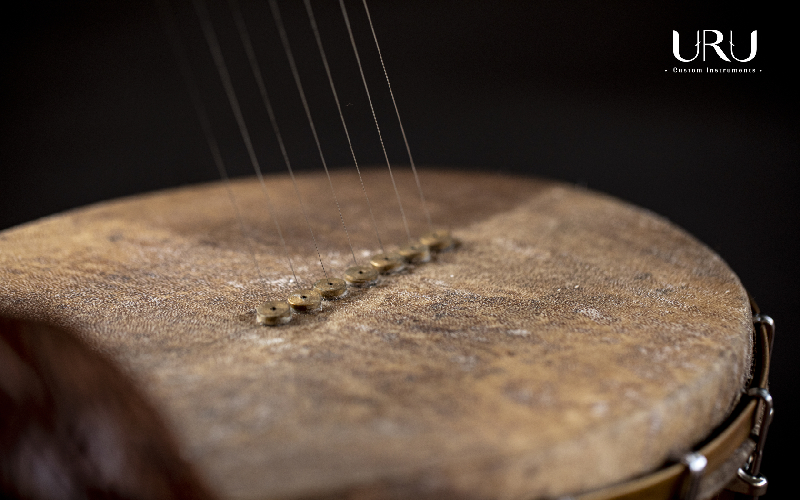
Cultural References
Chennai-based 24-year-old luthier, Tharun Sekar has been into recreating the Yazh since 2019. His extensive research brought a few things to light: the absence of audio recordings detailing its history or its sound and the available material seemed more poetic than technical.
“For instance, in scriptures, a Yazh has been compared to a glowing eight-month pregnant woman whose beauty is enhanced by the turmeric generously applied on her face,” recounts Tharun.
Let’s look at what Thiruvalluvar said about the Yazh:
“Kuzhal inidhu Yazh inidhu enbadham, makkal mazhalai keladhavar.” (Arathuppal, verse:66)
This simple verse explains how the instrument was part of the Tamil culture.
Interestingly, if 'Silappadhigaaram' describes the body of the Yazh as a blooming flower, the book, 'Jeevaga Sindhamani' chronicles a Yazh competition held between the protagonist Seevaga and a Gandharva. Before the competition, the judge inspects the three Yazhs brought by Seevaga.
“The well-versed judge was a classic example of the cultural presence of the ‘Yazh’. After carefully inspecting the instruments, he rejected the first one as it was made using moist wood. The second was rejected under the pretext that it had been struck by the lightning,” says Tharun. He says this episode serves as a record for the apt state of wood needed to make a Yazh. The competition sequence also explains the correct sitting posture while playing the yazh.
According to the 'Silappadhigaaram', there were five major types of Yazh based on the number of strings: Sengotti Yazh (seven strings to play seven swaras); Sagoda Yazh (14 strings); Makara Yazh (19 strings), Periyazh (containing 21-29 strings which was closer to the Veena on which one can play 27 notes) and the Seeryazh. Also based on the landscape, ancient literature divided the land into five forms: Marutham, Mullai, Paalai, Neidhal and Kurunji. “It is believed that each of the region had a Paan (ancient scale of music) and also a Yazh that was unique to it,” says Tharun.
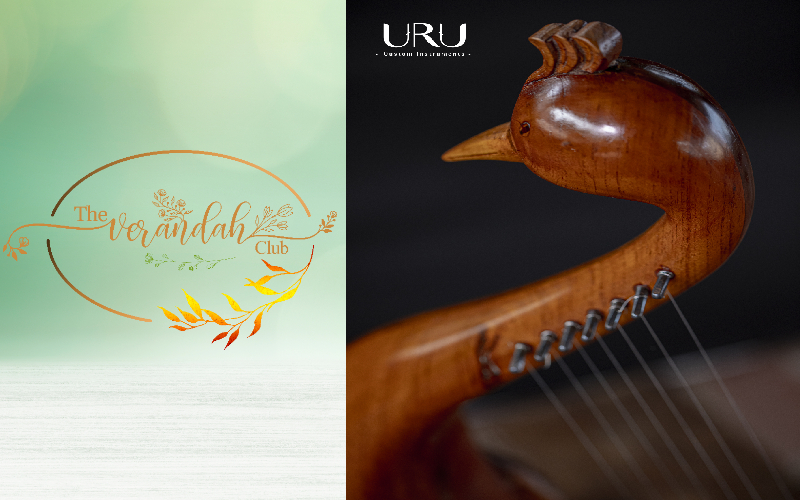
Yazh or Harp or Lyre?
The Yazh is often mistaken for a harp and a lyre, both hailing from the Greek world. While the Lyre existed around 2000 years ago, the yazh has a recorded history of 3000 years and an unrecorded history of beyond. In comparison, Harp is a relatively a modern instrument.
Let’s look at the basic form. Unlike the Harp, Yazh was aesthetically designed in the shape of a peacock, bull, fish and so on. But why these forms? It is interesting that Yazh was already designed based on ‘Harmonic Curve Theory’, in an age when anyone barely knew that such a musical theory existed. The theory was based on calculations (length, diameter and material used) to produce the desired note on the strings.
“There must have been a practical way of designing an instrument, which was on the same lines as the existing musical theories and measurements,” says Tharun.
The harp had a functional form which came with a wooden top. However, the yazh came with a top made with goatskin and a bowl-shaped resonator that created a natural reverberation. Conversely, a lyre was a compact instrument measuring 1-3ft in size and functional in design.
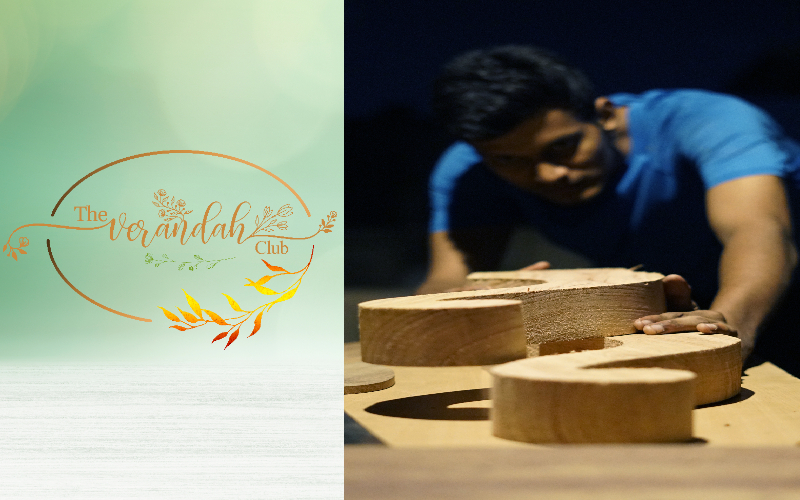
Design, Materials and Creation
According to Tharun, “Lending an aesthetic touch to whatever we designed has been part of our Tamil culture.” The Yazh is a classic example. Be it in the shapes of the ‘Yali’ (a unique mythological creature), Peacock, Bull or even the Fish, it perfectly suited the golden ratio.
The Semmaram (Red wood) or Palamaram (Jackfruit) wood were the ideal choices. The wooden top was made using the goatskin. At a time when metal strings were unavailable, the goat’s intestine became the best suited material. Flattened, dried and stretched out to different radii, thus were born durable gut strings that could bear the reverberation.
The excavated form of the wood turns into the bowl-like resonator. The tamarind seed paste was used to bind the skin: a technique used in a Kanjira. The wood-wood binder was a material called Arakku (laquer/lac).
But is the original form of the Yazh available today? “No. Just a non-playable model is found in three museums across Chennai: Raja Annamalai Mandram, Poompuhar handicrafts, Egmore museum, in Kerala and in Jaffna,” says Tharun.
So, with no playable form available and no YouTube tutorials to guide him, Tharun began his research on the Yazh. Sivasubramanian M., a Madurai based architect and a music researcher gave him the idea of making a Yazh.
“A friend from Sri Lanka is a student of Berkeley School of Music and a Harpist. She revealed that there is a strange instrument with no recorded history. She was referring to the Yazh. I mentioned this to Tharun in 2019. We did a quick search of the music repositories to crosscheck the fact,” he adds.
So, armed with technical knowledge from the ‘Yazh Nool’, Tharun began his journey towards creating his first yazh in 2019. The compilation of various research materials resulted in the recreation of the yazh.
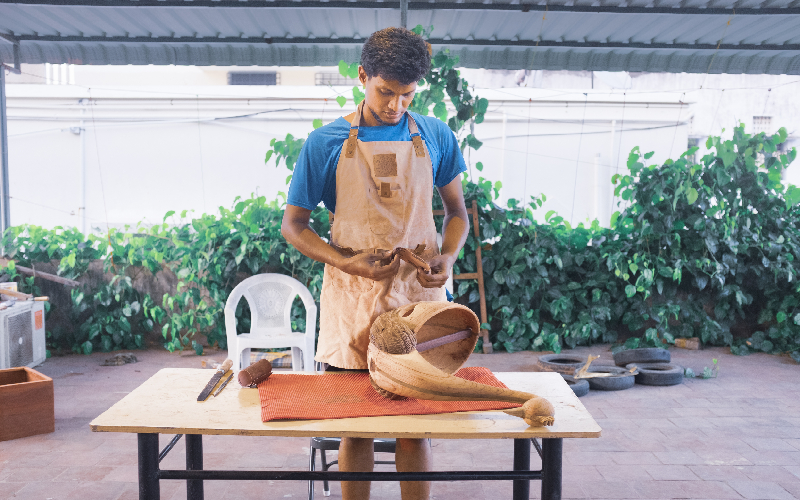
Tharun and the Yazh Connection
Multifaceted Tharun is a luthier, a singer and an architect. “As a 16-year-old, I had a rage for guitars. So, I learnt to play the guitar and making them. I thought that there was nothing too ‘cool’ about Indian instruments,” he reveals. However, the low visibility and interest when it came to learning Indian musical instruments made him curious. At 23, Tharun decided to create and recreate only Indian musical instruments.
So, the year 2019 marked the creation of ‘Uru’, his shop for redesigning Indian musical instruments. Tharun also began recreating his very first Sengotti Yazh. “Making a Yazh involves art, science and maths too,” says a smiling Tharun.
Sengotti Yazh is the simplest form of the instrument with seven strings. After six to seven months of research and a year to build the prototype, Tharun’s journey has been exciting.
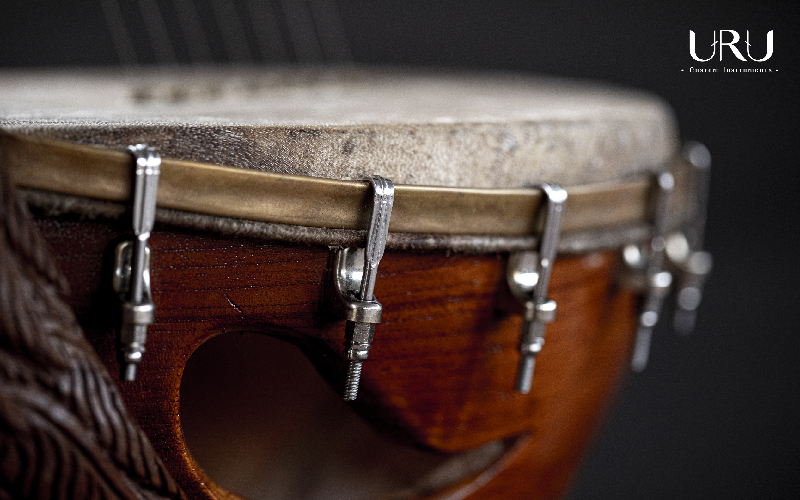
Challenges with Traditional Resources
However, how feasible is it to recreate the Yazh with the same materials?
“It’s absolutely possible since the resources are still available. In today’s world, more than procurement of the instrument, the focus is on maintaining an instrument,” reveals Tharun.
Let’s take the traditional materials such as the adhesives. “After unstringing the Yazh, every time the tamarind seed paste adhesive is to be replaced, the goat skin needs to be heated up. This is a tedious process in itself,” he explains. Even today, those who love the original sound produced by the instrument, prefer archetypal (goat intestine) strings in India and abroad.
“It’s still used to make many instruments like ‘Sarangi’, non-mainstream Guitars, Harp, Lyre etc.,” adds Tharun.
His idea is to give the sound of Yazh a global platform. Thus, adapting to modern technique will help the instrument sustain, Tharun reveals. He gives the history of guitar as an example. “Although 350-400 years old, around 100 types of guitars have been created so far. This is owing to the business model created to help the instrument sustain,” he adds.
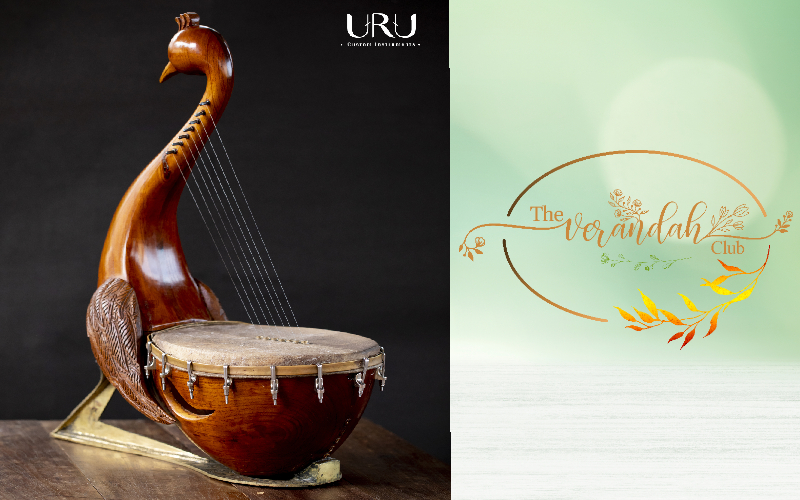
The Road to Modernisation
There are around eight types of wood in South India that could be used to make instruments. But while interning as an architect in Auroville, Tharun reveals that his mentor, Erisa Neogy, a luthier based in Auroville said that 30 kinds of wood could make great instruments.
Tharun’s choice is the Red Cedar, which is closer to the traditional wood used in ancient times. Not new to instrument-making, the wood is used to make the modern Tanpura and many other instruments.
“Interestingly, each wood produces a different ‘voice’. So, you need to closely listen to the wood,” reveals Tharun, who has been a luthier for the last seven years. It began with learning the craft and also treating the wood. So far, he has used only the Red Cedar wood for making the yazh.
“The merits would be doing away with the treble tone otherwise produced by the jackfruit wood. It’s weightless and also the produces a wider tonal quality,” he says. The base measures around one-feet in width, which is made using the excavated form of the wood.
Likewise, the goatskin gut strings are replaced by metal/nylon strings. He has introduced the ‘Hook and Bracket’ system to enable easy tuning of the instrument. Also, the tuning pegs are made using a 3mm measuring nickel plate.
“This peg does not bend easily and does not consume much space and very durable,” explains Tharun.
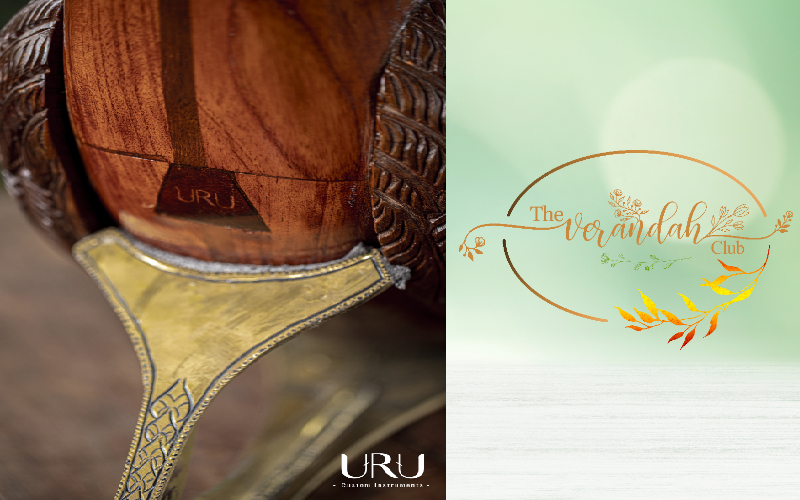
The Reception towards the Yazh
Siva has been experimenting with the sounds of the Yazh. He says that Tharun wanted to create a different kind of folklore on the lines of a harp or a lyre. The Yazh became the chosen one. “The idea was to play the Yazh on the street. Although possible, it is difficult to record the sound,” he adds. The sound of the Yazh is very susceptible to the atmosphere around it.
So, Siva has been experimenting with the sounds of the Yazh in different places for the sheer experience. He first played it behind a semi-closed cave in Thirupparankundram, Madurai. There is a small stream near the cave.
“The Yazh sounded very different. The tone produced was more nasal and the level of treble was more,” he explains. The next place chosen was the ‘Sayana Gopuram’ (near the gopuram) in the Kallazhagar Temple.
“The architecture of the sanctum is very different. I played the notes towards the sanctum and the result was mellifluous. The notes were more sustained, and it was possible to play different combination of notes,” says Siva. A septuagenarian singer and a music researcher from Madurai, Mammadhu Aiyya also gave his inputs to improvise the instrument. “He was very glad to play the Yazh,” recalls Tharun.
So, who are the people who have ordered for a Yazh recently? A music student from the Harvard University, a dancer from Norway have placed orders for the Yazh. Tharun reveals that the customers fall into three categories: 1. Those who love the way it sounds; 2. Those interested in the craft and 3. Those who are interested in the history of the instrument.
Currently, Tharun is working on a 14-stringed Yazh. Also, he is recreating a kai vazhi, which is believed to be the instrument used by musical nomads, paanars. “Since the paanars were constantly on the move, the design demanded that the seven-stringed instrument was sleeker and lesser in volume,” says Tharun.
So, what does the real creator Tharun wish to experiment with? He recalls how making guitars was a very personal experience. He never exhibited them to anyone. “The list is long. Basically, I would like to use different types of wood. More than that, I would like to create a yazh just for myself,” ends Tharun.
Janani Rajeswari is a freelance journalist who feels writing is a way of staying happy and positive. She teaches foreign languages. She also loves music, pets, books, movies, art and craft and learning new languages.
NEXT ARTICLE